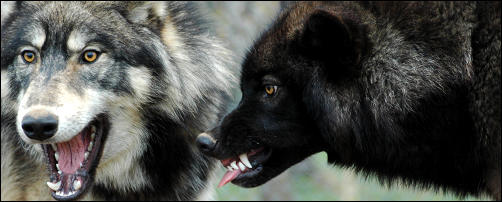How do wolves communicate?
 Communication is why wolves are such a successful predator - it allows them to work in a pack extremely well, which in turn allows them to hunt, protect each other and their territory and raise their young more safely. So, in other words, communication is key to their survival. Wolves are most known for their howling; it allows them to send a message to other wolves and it might mean “I’m here, where are you?” or they could be saying “stay away from my territory!”.
Communication is why wolves are such a successful predator - it allows them to work in a pack extremely well, which in turn allows them to hunt, protect each other and their territory and raise their young more safely. So, in other words, communication is key to their survival. Wolves are most known for their howling; it allows them to send a message to other wolves and it might mean “I’m here, where are you?” or they could be saying “stay away from my territory!”.
However, wolves talk to each other with more than just howls, they whimper, whine, growl, yelp, snarl and (rarely) bark. Wolves have 4 main senses of communicating with each other - auditory senses (which are sound, by howling, growling, yelping etc), olfactory senses (which are scents, by sniffing where another wolf has been or marking their territory by urinating), visual senses (by body language, such as standing tall or eye contact) and tactile senses (by touch, such as rubbing up against one another).
Visual senses, through body language, are a very important way they communicate. If you were a high ranking (dominant) wolf you would hold your head and tail high when greeting others whereas if you were a lower ranking (submissive) wolf you would tuck your tail between your legs, have a low body / head position and flatten your ears when you were greeting a higher ranking animal. When a wolf is angry they may represent this by showing their teeth and giving a "hard" stare to the wolf annoying them, below is an example of Tala doing just that!

When a wolf wants to play it bows – lowering the front half of its body while its rump stays in the air, tail wagging. You might see your pet dogs do this when they want to play; the reason is that dogs and wolves are closely related and the ways they communicate are similar. Wolves can also express a lot with their eyes, an angry or negative feeling would result in a "hard" look, and a sharpening of the eye, whereas if they are happy or playful they have a "soft" look to their eyes.
In the wild wolves don't have walls and fences marking their homes and territory - instead they urinate around their borders and rub their and their pack's scents all around the area they've claimed to let others know who it belongs too!




